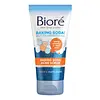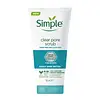What's inside
What's inside
 Key Ingredients
Key Ingredients

 Benefits
Benefits

 Concerns
Concerns

 Ingredients Side-by-side
Ingredients Side-by-side

Water
Skin ConditioningSodium Cocoyl Isethionate
CleansingGlycerin
HumectantGlycol Distearate
EmollientSynthetic Wax
AbrasiveEthoxydiglycol
HumectantPEG-6 Caprylic/Capric Glycerides
EmulsifyingMicrocrystalline Wax
Emulsion StabilisingCetyl Alcohol
EmollientPEG-12 Dimethicone
Skin ConditioningSodium Lauroyl Lactylate
EmulsifyingSodium Hydroxide
BufferingAcrylates/C10-30 Alkyl Acrylate Crosspolymer
Emulsion StabilisingXanthan Gum
EmulsifyingSodium Benzoate
MaskingParfum
MaskingMenthol
MaskingSodium Bicarbonate
AbrasiveBenzophenone-4
UV AbsorberCI 19140
Cosmetic ColorantTalc
AbrasiveCI 73360
Cosmetic ColorantAgave Tequilana Leaf Extract
AstringentSalicylic Acid
MaskingWater, Sodium Cocoyl Isethionate, Glycerin, Glycol Distearate, Synthetic Wax, Ethoxydiglycol, PEG-6 Caprylic/Capric Glycerides, Microcrystalline Wax, Cetyl Alcohol, PEG-12 Dimethicone, Sodium Lauroyl Lactylate, Sodium Hydroxide, Acrylates/C10-30 Alkyl Acrylate Crosspolymer, Xanthan Gum, Sodium Benzoate, Parfum, Menthol, Sodium Bicarbonate, Benzophenone-4, CI 19140, Talc, CI 73360, Agave Tequilana Leaf Extract, Salicylic Acid
Water
Skin ConditioningHamamelis Virginiana Leaf Water
AstringentCocamidopropyl Betaine
CleansingGlycerin
HumectantBambusa Arundinacea Stem Extract
Skin ConditioningSodium Laureth Sulfate
CleansingPEG-7 Glyceryl Cocoate
EmulsifyingAcrylates/C10-30 Alkyl Acrylate Crosspolymer
Emulsion StabilisingBenzophenone-4
UV AbsorberCitric Acid
BufferingHydroxypropyl Cyclodextrin
MaskingIodopropynyl Butylcarbamate
PreservativeNiacinamide
SmoothingPanthenol
Skin ConditioningPantolactone
HumectantPhenoxyethanol
PreservativePotassium Sorbate
PreservativeSodium Benzoate
MaskingSodium Chloride
MaskingSodium Hydroxide
BufferingThymus Vulgaris Flower/Leaf Extract
MaskingXanthan Gum
EmulsifyingZinc PCA
HumectantWater, Hamamelis Virginiana Leaf Water, Cocamidopropyl Betaine, Glycerin, Bambusa Arundinacea Stem Extract, Sodium Laureth Sulfate, PEG-7 Glyceryl Cocoate, Acrylates/C10-30 Alkyl Acrylate Crosspolymer, Benzophenone-4, Citric Acid, Hydroxypropyl Cyclodextrin, Iodopropynyl Butylcarbamate, Niacinamide, Panthenol, Pantolactone, Phenoxyethanol, Potassium Sorbate, Sodium Benzoate, Sodium Chloride, Sodium Hydroxide, Thymus Vulgaris Flower/Leaf Extract, Xanthan Gum, Zinc PCA
Ingredients Explained
These ingredients are found in both products.
Ingredients higher up in an ingredient list are typically present in a larger amount.
Acrylates/C10-30 Alkyl Acrylate Crosspolymer is a synthetic polymer. It is used to thicken and improve the texture of products. Due to its properties, it can prevent water and oil ingredients from separating.
Benzophenone-4 is a water-soluble chemical sunscreen.
It protects in the UV-B range, but is considered a secondary UV absorber. This means that it needs to be paired with other sunscreen ingredients to provide effective protection.
Typically, it's used in cosmetic products to protect them from deterioration caused by UV rays. This is why you'll find it in a lot of products that aren't sunscreens.
Learn more about Benzophenone-4Glycerin is already naturally found in your skin. It helps moisturize and protect your skin.
A study from 2016 found glycerin to be more effective as a humectant than AHAs and hyaluronic acid.
As a humectant, it helps the skin stay hydrated by pulling moisture to your skin. The low molecular weight of glycerin allows it to pull moisture into the deeper layers of your skin.
Hydrated skin improves your skin barrier; Your skin barrier helps protect against irritants and bacteria.
Glycerin has also been found to have antimicrobial and antiviral properties. Due to these properties, glycerin is often used in wound and burn treatments.
In cosmetics, glycerin is usually derived from plants such as soybean or palm. However, it can also be sourced from animals, such as tallow or animal fat.
This ingredient is organic, colorless, odorless, and non-toxic.
Glycerin is the name for this ingredient in American English. British English uses Glycerol/Glycerine.
Learn more about GlycerinSodium Benzoate is a preservative. It's used in both cosmetic and food products to inhibit the growth of mold and bacteria. It is typically produced synthetically.
Both the US FDA and EU Health Committee have approved the use of sodium benzoate. In the US, levels of 0.1% (of the total product) are allowed.
Sodium benzoate works as a preservative by inhibiting the growth of bacteria inside of cells. It prevents the cell from fermenting a type of sugar using an enzyme called phosphofructokinase.
It is the salt of benzoic acid. Foods containing sodium benzoate include soda, salad dressings, condiments, fruit juices, wines, and snack foods.
Studies for using ascorbic acid and sodium benzoate in cosmetics are lacking, especially in skincare routines with multiple steps.
We always recommend speaking with a professional, such as a dermatologist, if you have any concerns.
Learn more about Sodium BenzoateSodium Hydroxide is also known as lye or caustic soda. It is used to adjust the pH of products; many ingredients require a specific pH to be effective.
In small amounts, sodium hydroxide is considered safe to use. However, large amounts may cause chemical burns due to its high alkaline.
Your skin has a natural pH and acid mantle. This acid mantle helps prevent harmful bacteria from breaking through. The acid mantle also helps keep your skin hydrated.
"Alkaline" refers to a high pH level. A low pH level would be considered acidic.
Learn more about Sodium HydroxideWater. It's the most common cosmetic ingredient of all. You'll usually see it at the top of ingredient lists, meaning that it makes up the largest part of the product.
So why is it so popular? Water most often acts as a solvent - this means that it helps dissolve other ingredients into the formulation.
You'll also recognize water as that liquid we all need to stay alive. If you see this, drink a glass of water. Stay hydrated!
Learn more about WaterXanthan gum is used as a stabilizer and thickener within cosmetic products. It helps give products a sticky, thick feeling - preventing them from being too runny.
On the technical side of things, xanthan gum is a polysaccharide - a combination consisting of multiple sugar molecules bonded together.
Xanthan gum is a pretty common and great ingredient. It is a natural, non-toxic, non-irritating ingredient that is also commonly used in food products.
Learn more about Xanthan Gum